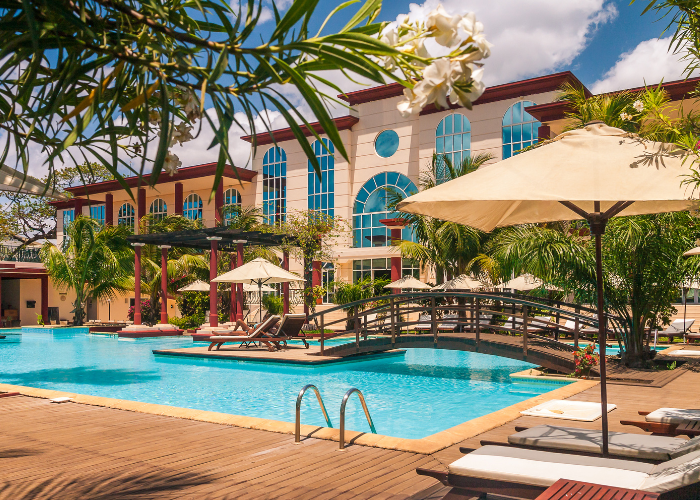The travel and tourism market is predicted to have 135.5 million users from 2024 to 2028. If you capitalize on this growth, you could enjoy an impressive 6% to 12% return on your investment.
But how much does it cost to build a hotel?
Plus Render gives you an overview of the costs involved so you can make the right business decisions and formulate an appropriate budget. We also explain how photorealistic renderings can help you attract investors.
How Much Does It Cost To Build a Hotel?
According to HomeGuide, a website for homeowners, hotels on average cost $13 to $32 million to build. It further estimates that the minimum cost of building one is $7.5 million.
Of course, luxurious 5-star hotels cost more.
Numerous factors—such as the geographic location, type of hotel, size of the project, permits, and labor—determine the final cost.
Allow us to illustrate this fact by comparing Arizona and Hawaii. In Arizona, the median cost of land is $4,164 per acre. But in Hawaii, each acre easily costs hundreds of thousands of dollars.
For a more thorough understanding, let’s take a closer look at these factors in the next section.
Factors Affecting the Cost of a Hotel
How much does it cost to build a hotel? These aspects will give you a rough idea:
Land Acquisition
Figures from LandSearch peg an acre of land in the United States at $16,000. In cheaper areas, an acre can cost under $1,000 while farmland and commercial lots can be higher than $100,000 an acre.
The cost of land goes up with time so the cost of acquiring land for your project could exceed 14% of your total project cost.
Type of Hotel
Hotels can be categorized in a variety of ways based on service type.
Full-service boutique hotels are generally more expensive to build due to the cost of amenities. Adding an on-site restaurant to the plan can add another $175,000 to $750,000 to your expenses based on the size and concept.
The costs will be substantially less for motels and extended-stay facilities as guests who frequent them prioritize exploring their destination.
Star Ratings
The star rating system is used to classify the type of features, range, and quality of amenities as well as the level of cleanliness you can expect from an establishment.
The higher the rating, the more luxurious the experience and the steeper the price.
Here’s an idea of what you can expect to spend across these categories:
- Five-star hotels with high-end service, comfort, and in-room amenities are around $330 to $550 per square foot.
- Four-star hotels with upscale features like pools, hot tubs, and on-site dining cost $260 to $410 per square foot.
- Three-star hotels that balance comfort, luxury, and affordability cost $190 to $380 per square foot.
Finally, two-star and one-star hotels are the cheapest to build. Their focus is on providing basic accommodations and not Insta-worthy aesthetics.
Hard Costs
Hard costs, also known as direct or tangible costs, refer to the expenses of building a property. They typically comprise the largest portion of your budget at 70% to 85% of the total construction costs.
They include:
- Cost of materials like concrete, steel, and bricks
- Skilled and unskilled labor
- Cost of equipment like excavators, bulldozers, and cranes
Green buildings cost even more as they call for sustainable materials, which are typically 75% to 85% more expensive than conventional products.
Soft Costs
Soft costs refer to intangible aspects indirectly tied to construction. They include:
- Marketing, promotion, and advertising
- Insurance costs
- Maintenance costs
- Legal and administrative costs
- Fees paid to architects and decorators for blueprints and designs
Expect to allocate a minimum of 15% to 30% of the hotel’s construction budget to this category. After all, you also have to consider sales and leasing costs, taxes, and post-occupancy expenses.
Furnishing
Another 30% will be spent on FF&E (furniture, fixtures & equipment). This goes toward furniture which typically accounts for 10% of the budget. This can cost $3,000 to $40,000 per room based on the quality of the pieces and how many of them you need.
Brand Affiliation
Branding builds credibility. Studies show that brand reputation is the sole determinant of preference. This explains why boutique hotels enjoy an average of up to 14% net profit margin.
However, this comes at a cost—a sweet $115,000 to $1.5 million per room.
Why the Preconstruction Process Is Important for Attracting Investors
Aspiring hotel owners have the difficult task of earning the buy-in of investors and other stakeholders. With their assistance and cooperation, you can mobilize the necessary resources to erect your establishment and give it a promising start.
But how do you get them onboard?
Ironing out a solid pre construction process is key. These services are an upgrade to the design-bid-build project delivery method. Supported by schematic designs, space conceptualizations, and process workflows, they provide contractors and owners visibility into every little detail.
Pre Construction focuses on ensuring compliance with local, state, and federal regulations. It’s also pivotal for ensuring that deadlines are met. This is an important consideration since only 30% of contractors finish projects on time.
During this stage, decision-makers use their experience to identify and adopt cost-saving measures to meet clients’ needs without going over fixed budgets.
Preconstruction comprises up to 2% of the construction budget.
Professional Renderings: For Hotel Real Estate Development That Sells
Using renders to aid the visualization of various real estate developments has become popular. They are even more important when it comes to building hotels. Large-scale renderings offer photorealistic 3D visualizations of what the hotel will look like once built.
From layouts to features, furniture, and amenities, they convey even the most complex design concepts with ease and without technical jargon! The immersive viewing experience captivates audiences, giving them confidence in your vision and helping them make informed decisions.
In addition, large-scale renderings also:
Facilitate Seamless Communication
Large construction projects typically take 20% longer to finish than scheduled. The complexity of the project paired with inadequate project management and planning can lead to huge delays, which can impact reputation and profitability.
Large-scale rendering solves this issue by providing a deep understanding of complex and abstract concepts. It ensures all parties involved have a clear roadmap, increasing the chances that development will go according to plan.
Reduce the Risk of Errors
Between 10% and 35% of project costs are lost due to errors. Hence it’s important to leverage 3D renderings to enhance efficiency and reduce mistakes.
Detailed visualizations reveal design flaws and other potential issues, allowing you to make the necessary adjustments and avoid costly errors.
It streamlines the entire process, taking miscommunication and misinterpretation out of the equation to save time and money.
Improve your Chances of Making a Successful Pitch With Interactive Virtual Tours
50% of adults on the internet rely on virtual tours in their research and decision-making. This transformative technology holds the same potential for interested investors during hotel preconstruction.
Viewers can enjoy interactive simulations of the hotel property. They can explore the space, check out the room options, pass through doors, and experience it as if they were physically there.
Think of the convenience it provides!
Take Home Message
How much does it cost to build a hotel? On average, hotels cost $13 to $32 million to build. Your budget must take into account several factors, including:
- The cost of acquiring land
- The type of hotel you want to build
- Its star rating
- Hard and soft costs
- The cost of furniture, fixtures, and equipment
- Your branding
Before building, you’ll need to create comprehensive plans and enlist the cooperation of several groups of stakeholders. Plus Render can help you communicate your vision and win buy-in.
As a visualization studio, we create compelling, accurate, and highly detailed renders that showcase the overall structure and its countless small details. Our artists and technical experts ensure smooth planning and construction, impressive presentation, and more accurate budgeting.Book a call for visualization solutions that will turn your ideas into reality.







